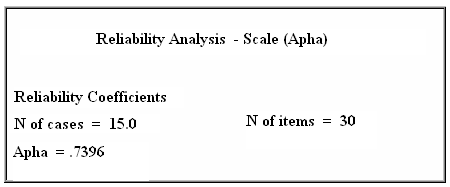Reliability is a measure of the degree to which a research instrument yields consistent results after repeated trials (Mugenda & Mugenda, 1999). An instrument is reliable when it can measure a variable accurately and obtain the same results over a period of time. Reliability is about internal consistency of research instruments; it is the ability of research instruments to produce similar results time and again under consistent conditions. The most common measure of reliability is Cronbach’s alpha, which is usually interpreted as the mean of all possible split-half coefficients (Cortina, 1993).
In order to determine the reliability of research instruments, pilot test is conducted. The instruments are administered to an ‘independent sample’ (a sample which is not part of the final sample) but which enjoys the same characteristics as the study sample. Reliability of the instruments is then estimated from the collected data.
Reliability may be estimated through a variety of methods that fall into two types: single-administration and multiple-administration. Single administration requires only one assessment while multiple-administration method requires that two assessments are administered.
Single-administration method include split-half method, which uses two halves of a measure, that is odd and even items as alternate forms. The method involves administering a test to a selected sample of individuals, splitting the test in half (odds and evens) and correlating scores on one half of the test with scores on the other half of the test. The correlation between the two set of scores is used to estimate the reliability of the instruments.
Multiple-administration method includes test-retest method which involves administration of the instrument twice within a given time interval (could be after two weeks). The two set of scores are correlated to establish the reliability of the instruments.
Cronbach ’s alpha reliability coefficient normally ranges between 0 and 1. However, there is actually no lower limit to the coefficient. The closer Cronbach ’s alpha coefficient is to1.0 the greater the reliability of the items in the scale. George and Mallery (2003) however, provide the following rules of thumb:
“_>.9 – Excellent, _>.8 – Good,,_>.7 – Acceptable,,_>.6 – Questionable,,_>.5 – Poor and _<.5 – Unacceptable ” (p.231).
Example 1
Suppose you have a 30-items questionnaire, you can establish the reliability with the help of SPSS. The application comes in handy in processing the random subsets of items and in computing the resulting correlations.
Steps after coding the 30-item questionnaire (SPSS Ver 11.5): Analyze>Scale>Reliability Analysis>Select all items and click the arrow button on the right> Select alpha>Click Ok. Table 1 shows the alpha results.
Table 1
Cronbach’s alpha reliability coefficient for a 30-items Questionnaire
The reliability was computed with the help of SPSS using Cronbach’s alpha for a 30-items questionnaire. Upon computation, alpha of .7396 was obtained. The questionnaires were thus accepted as reliable (George & Mallery, 2003).
Example 2
In order to obtain reliability of the questionnaire, a test-retest method was used to pilot it in order to estimate the degree to which the same results could be obtained with a repeated measure of accuracy from the same instrument. The questionnaire (students’) was administered to ten (10) respondents. These came from a population that shared similar characteristics but they were not part of the study sample. The researcher in person collected the pilot data. After a period of two weeks, the same questionnaire was administered to the same group of respondents. Reliability coefficient between the two sets of scores was coded and analyzed with the help of Statistical Package for Social Sciences (SPSS) version 11.5. This yielded 0.7554 reliability coefficient. Thus, the questionnaire was accepted as reliable (George & Mallery, 2003).
References
Cortina, J.M. (1993). What Is Coefficient Alpha? An Examination of Theory and Applications. Journal of Applied Psychology, 78(1), 98–104.
George, D., & Mallery, P. (2003). SPSS for Windows step by step: A simple guide and reference.11.0 update (4 th ed.).Boston: Allyn &Bacon.
Mugenda, O. M., & Mugenda, A. G. (1999). Research methods: qualitative and quantitative approaches. Nairobi: Acts Press.

